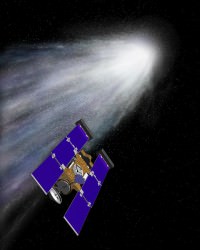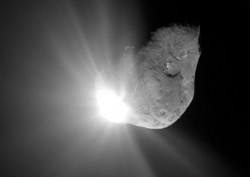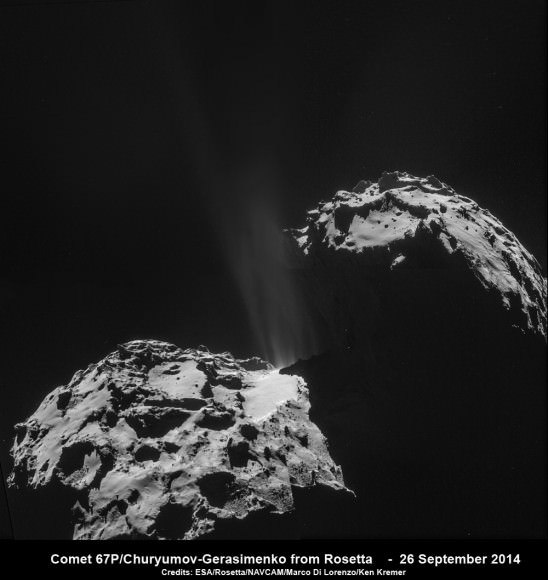The idea of panspermia — that life on Earth originated from comets or asteroids bombarding our planet — is not new. But new research may have given the theory a boost. Scientists from Japan say their experiments show that early comet impacts could have caused amino acids to change into peptides, becoming the first building blocks of life. Not only would this help explain the genesis of life on Earth, but it could also have implications for life on other worlds.
Dr. Haruna Sugahara, from the Japan Agency for Marine-Earth Science and Technology in Yokahama, and Dr. Koichi Mimura, from Nagoya University said they conducted “shock experiments on frozen mixtures of amino acid, water ice and silicate (forsterite) at cryogenic condition (77 K),” according to their paper. “In the experiments, the frozen amino acid mixture was sealed into a capsule … a vertical propellant gun was used to [simulate] impact shock.”
They analyzed the post-impact mixture with gas chromatography, and found that some of the amino acids had joined into short peptides of up to 3 units long (tripeptides).
Based on the experimental data, the researchers were able to estimate that the amount of peptides produced would be around the same as had been thought to be produced by normal terrestrial processes (such as lighting storms or hydration and dehydration cycles).

The earliest known fossils on Earth are from about 3.5 billion years ago and there is evidence that biological activity took place even earlier. But there’s evidence that early Earth had little water and carbon-based molecules on the Earth’s surface, so how could these building blocks of life delivered to the Earth’s surface so quickly? This was also about the time of the Late Heavy Bombardment, and so the obvious answer could be the collision of comets and asteroids with the Earth, since these objects contain abundant supplies of both water and carbon-based molecules.

Space missions to comets are helping to confirm this possibility. The 2004 Stardust mission found the amino acid when it collected particles from Comet Wild 2. When NASA’s Deep Impact spacecraft crashed into Comet Tempel 1 in 2005, it discovered a mixture of organic and clay particles inside the comet. One theory about the origins of life is that clay particles act as a catalyst, allowing simple organic molecules to get arranged into more and more complex structures.
The news from the current Rosetta mission to comet 67P/Churyumov-Gerasimenko also indicates that comets are a rich source of materials, and more discoveries are likely to be forthcoming from that mission.

“Two key parts to this story are how complex molecules are initially generated on comets and then how they survive/evolve when the comet hits a planet like the Earth,” said Professor Mark Burchell from the University of Kent in the UK, commenting on the new research from Japan. “Both of these steps can involve shocks which deliver energy to the icy body… building on earlier work, Dr. Sugahara and Dr. Mimura have shown how amino acids on icy bodies can be turned into short peptide sequences, another key step along the path to life.”
“Comet impacts are normally associated with mass extinction on Earth, but this works shows that they probably helped kick-start the whole process of life in the first place,” said Sugahara. “The production of short peptides is the key step in the chemical evolution of complex molecules. Once the process is kick-started, then much less energy is needed to make longer chain peptides in a terrestrial, aquatic environment.”
The scientists also indicated that similar “kickstarting” could have happened in other places in our Solar System, such as on the icy moons Europa and Enceladus, as they likely underwent a similar comet bombardment.
Sugahara and Mimura presented their findings at the Goldschmidt geochemistry conference in Prague, going on this week.


But if several of these comets were capable of incubating life, and the Earth was undergoing a period of great bombardment, wouldn’t that make it much more probable that each (or at least many) of those comets contributed something that eventually evolved into our current life forms?
That would violate the immutable law that all life on Earth must have had a single common ancestor.
“Building blocks” and “seeds of” life theoretically came here via comets, not life itself. That would then mean that LIFE then originated in situ FROM these seeds, once deposited here, allowing it to then become one common chemical chain which would lead to common Earth bound ancestry.
FWIW, there isn’t a law of a universal common ancestor [UCA], and already Darwin recognized that. It is true that the tree-like topology of lineage divergence makes for common ancestors [CAs] but the number of life emergences is in principle open.
It is instead an observation, whether or not life emerged multiple times, of a surviving and rather late universal common ancestor [LUCA] that the evolution of the genetic machinery presents us with. It is, arguably, the best observed fact in all of science* due to the combinatorial nature of tree topologies, on the order of 10^2000 against multiple CAs. [ http://www.ncbi.nlm.nih.gov/pubmed/20463738 ]
Possibly concurrent separate lineages went extinct. Possibly early cells leaked so much genetic material that it was more of a bush than even today (and some leakage must have been present to moot Muller’s ratchet of too little recombination). And possibly, nay likely, the gradualism of evolutionary divergences moot the very early sense of isolation; at this point we leave over to Jeffrey’s comment…
* In the sense of a test and its uncertainty.
That’s panspermia idea is science is one of the most hilarious idea or guess from our scientists today. The reason why they are guessing or endorsing this fantasy because they did not yet know the real “intelligence” and the new “Intelligent Design ” that I’ve discovered! Life and existence follow the real intelligence…know it and you will know how nature works/behaves!
My goodness! If we let those scientists reign our science, all humans will die dumb!
What makes you think ‘Intelligent Design’ is any more credible a *theory* than panspermia?
At least this panspermia article isn’t trying to plug a book 😉
Not as hilarious idea as posting erroneous religious comments on a science blog…
Here is the deal, Aim a Comet at any Planet/Moon in the Cosmos that has liquid water make contact (like sperm to an egg) wait a few million years and like magic we have.. Life (don’t believe it?) just wait until we look under the Ice on Europa……
But when once again we don’t find it, you will only say that it MUST have occurred Some where on some Other planet or moon. This theory is worth checking out, but cautiously without great these claims that it Must be true.
Interesting! Seems one can get peptides in about every non-equilibrium wet chemistry (dry/wet cycles, impacts, …).
Here is an interesting summary of years of painstaking research, now at the level of individual atoms, into the Jack Hill zircons and what they can tell us of crust and ocean fromation from John Valley himself: http://www.minsocam.org/MSA/AmMin/TOC/2015/open_access/AM100P1355.pdf
Turns out that the oldest ~ 4.40 Ga bp [billion years before present] zircon must be dismissed for the latter (but verify a crust), but figure 17 shows how a cluster of undamaged crystals verify an ocean before 4.3 Ga bp.
There is scatter, but one can even imagine a gradual hydration of Earth. That would fit with the recent agreeing clocks for dating the Moon producing collision which use an accumulating impact veneer, and with the resulting water content from Vesta type impactors.
With a collision ~ 90 Ma after the protoplanetary disk formation, that would put a hot, dry Earth emerging ~ 4.7 Ga bp, with a survivable (Late Heavy Bombardment scale) impact flow some 4.5 Ga bp. Perhaps the crust thought so too. =D
Oy. I meant to write ~ 4.47 Ga bp old Earth, with ~ 4.45 Ga bp as the survivable impact flow rate.
As this article mentions, ” the researchers were able to estimate that the amount of peptides produced would be around the same as had been thought to be produced by normal terrestrial processes (such as lighting storms or hydration and dehydration cycles).” It would seem to me that these terrestrial processes are so MUCH more common than comet or meteor impacts that this theory represents an almost negligible possibility. Why credit such impacts if these short peptides are being produced all the time right here?
Imagine a great ocean of almost infinite size and ask yourself if one and only one molecule in that vast ocean could possibly be completely and totally different than every other of the quadrillions upon quadrillions of molecules that exist in that ocean. As a scientist you would say that it’s within the realm of possibility, but you would also point out that science would also suggest that it is mathematically improbable, if not downright impossible for that to occur.
It is for that reason, in my opinion, that the theory of Panspermia, although still just a theory, cannot be so easily dismissed.
Our planet can be viewed as nothing more than a single molecule in the vast ocean of space, and to think that this one molecule is completely unique from every other molecule is to believe an in almost impossible mathematical probability.
I understand your thinking. Yet it is absolutely amazing what we are discovering regarding the multiplicity of possibilities of planet conditions which are incompatible with life as we know it. Even our sister planet Venus which lies in the “Goldilocks Zone” is obviously inhospitable, and Mars which lies a bit beyond that zone certainly can’t serve those needs, at least today.
So we turn to the moons of Jupiter and Saturn which might serve as hosts to life, and future probes will undoubtedly be sent search for those signs, even though the conditions are far from those on our green earth.
Then we will turn to the exo-planets and insist life MUST exist on one of those, probably in the Goldilocks Zone there, and there will be hints of suitable conditions based on the atmospheres we are learning to detect. The Martian atmosphere has been teasing us with such indications, and so we will continue to send probes there (and even boots-on-the-ground) to investigate and determine whether the source of those gases is from bacteria, or merely the non-living chemical reactions which produce those same gases even here on earth. I’m not willing to bet any of my chips that we will find any definitive evidence of past or present life there either, although the search is certainly fun.
However, we will most likely never be able to get probes to any exo-planets/moons to investigate such indications. The search will go on, but due to the incredible complexity of the requirements needed to host life, I am becoming increasingly doubtful that we will turn up anything definitive, only tantalizing possibilities.
Even if we find “another molecule in the vast ocean of space that is identical with ours” there is the next problem:
If we DO discover a planet/moon that could host life, this is NO indication that it actually does. By now we ought to be able to demonstrate that if we throw the right minerals and molecules together, they will produce something living. We have been stymied there as well. We just can not demonstrate this process, and continue that search as well, with increasing bewilderment. It would appear that there are certain “irreducible complexities” needed that require something beyond what we can imagine. It just is not happening.
So even if we should find that other elusive planet, this would be NO indication that it hosts life like ours. I would hate for us to revert back to the Dark Ages, when people believed that rats and flies automatically emerged from the great garbage heaps of the cities. We call that spontaneous regeneration, and laugh at the ignorance of that day. Let’s not fall into that same thinking, simply because we desire that there be multiple planets in our universe hosting other life forms. It’s just not easy at all. By all means search, but let’s be more realistic about our expectations and claims.
We just don’t have enough information at this point in time. When I was growing up in the 1970’s the scientists of the day were mostly adamant that life could not exist anywhere else in the solar system. Today that assertion is less certain as we find an increasing number of bodies that might have suitable environments to support simple water/carbon-based life-forms.
But that last sentence introduces that other great assumption – that all life has to be based on carbon/water-based chemical processes. It could be that life in other entirely alien environments, with exotic temperatures or pressure ranges is entirely tenable using alternate chemistry for biological processes.
There’s no proof either way; so a wise mind is one left open. But the Universe is an awfully large place for only one kind of life to have evolved in only one place.
Supposing one could assemble enough of these building blocks in the correct order, there still remain significant obstacles to turning that into life. But we’re eating the elephant one bite at a time; let’s not concern ourselves with that.
For a theory to be religious, it would have to depend on a revelation, ie, “God told me”. If I was exploring an island and I wondered if it had ever been inhabited, you’d call me irrational to doubt it if I found tools, documents, buildings and roads. Those things don’t just happen, they need to be made, and what’s more they require intelligence to make them. I look at the complexity of DNA, proteins, and their interactions, and I conclude such things cannot be assembled without intent. Certainly no one can point to any counter examples. I therefore rationally conclude an intelligent designer is responsible.
LHB and cometary impactors are interesting for both the posibility of bringing complex organics and water to earth after the earth and moon coalesced from two protoplanets coliding. Also interesting for biogenesis are hydrothermal vents (ocean) and geothermal vents (hotsprings). Mono lake in california is a fantastic example of very different lifeforms evolving directly from such catalysts…
SciFi short?: Mankind stumbles into the future relatively unscathed yet severely chastised and wizened after several near catastrophic extinction events. Afterwards we learn to honor all life. Eventually, we master spaceflight and find our way around the local star group(s). What we find is disheartening for those who had hoped to find advanced lifeforms amongst the stars. There aren’t any… As our technical prowess continues we decide to genetically manipulate certain ‘seed stocks’ to terraform wherever we find stellar and planetary circumstances just right. We evolve to become ‘galactic gardeners’ for want of a better term, who realize the long wait for evolution and that we will never know the extent of our successes. A loop in time is eventually found where travel to the past is made possible. We decide to return to our point of origin to collect pre-extinction species for further transplantations. Ancient hominid progenitors see us and begin to record myths of ‘Angels’ and other-worldly beings…
Panspermia is a dead end. It’s a shame that Universe Today supports it.